| Destinations
|
|||
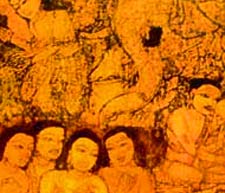 It takes barely two hours to cover the 99 km. from Aurangabad to Ajanta, two hours to transport you to the second century B.C. when the first of these caves was hollowed out from the side of the cliff.
It takes barely two hours to cover the 99 km. from Aurangabad to Ajanta, two hours to transport you to the second century B.C. when the first of these caves was hollowed out from the side of the cliff.
Early in the 19th century a party of British officers scrambling over the thickly wooded slopes of the Sahyadri hill, discovered these caves buried under debris and screened by foliage. Strung out in a sweeping horseshoe shape in an inner fold of the hills, the caves were a secluded retreat for Buddhist monastic orders and yet offered easy access to the trade routes that swung past here to the coast. With little more than hammer and chisel but with a deep faith inspiring them, these simple monks excavated chaityas, built chapels for prayer and viharas, monasteries where they lived and taught and carried out ritual performances. The 30 caves of Ajanta , some unfinished, span a period of 800 years and contain numerous images of Buddha. The sculptures in cave 26 are elaborate and beautiful: highlights here are the panel of the temptation of Buddha and the Parinirvana depicting the breaking of earthly ties and Buddha's passing into nirvana -- a wonderful recumbent figure amid people in attitudes of mourning and sorrow. |
Maharashtra • Forts • Panhala • Aurangabad • Ganapatipule • Hill Stations • Karnala • Borivli
Travelogues • Rock Climbing • Trekking • Paragliding Leisure • Elephanta Caves • Nature Trail |
||
Although tucked away deep within the folds of the hills, the sanctuaries are illuminated by natural light for some part of the day. Using metal mirrors to reflect sunlight into the inner recesses, monks and artists painted the wonderful frescoes that glow on these walls. These were in a fairly good state when the caves were first discovered but have deteriorated over the years with dampness and exposure to ever increasing numbers of tourists every year. Still in caves 1, 2, 16 and 17 you can see some undamaged portions of frescoes that are vibrant and clear, the fading colours recall how beautiful these caves must have been in centuries gone by. Ajanta is a protected monument under the Archaeological Survey of India and has been included in the World Heritage list of monuments. The Boddhisatvas who figure prominently in the Ajanta paintings are celestial beings, often personifications of the virtues of Buddha, who visit the world of men. In later Buddhist philosophy, the time when these rock shrines were hewn out of the hill side, the Boddhisatvas were beings who had renounced the attainment of nirvana to attend to human needs. The Boddhisatva Padmapani (cave 1) is a wonderful portrayal of the tender compassion that infuses his ministry to suffering mankind -- gentle eyes, delicate lips about to speak words of consolation and a lotus held in a beautifully drawn hand. In the same cave you see the golden figure of Avalokiteswara with an elaborate crown hung with looped strands of pearls; pearl necklaces adorn his handsome body and a gold girdle fastens his striped garment.
The flying aprasa (cave 17, fifth century) in a fashionable embroidered turban are a reminder of the splendid jewellery worn by high born women; the pearl tassels of her necklace and turban swing delicately with her aerial movement. Row upon row of Buddha figures 'The thousand Buddhas', intrigue the observer in cave 2. Queen Maya's dream of the white elephant are in cave 2. Queen Maya's dream of the white elephant, interpreted by royal astrologers to mean the birth of an illustrious son, is a detailed panel in cave 2. Look for the dark princess and the lively panel of a dancing girl and musicians (cave 1). Eloquent and moving is the Buddha with a begging bowl asking alms from his wife and son in cave 19. A court scene (cave 1) featuring a bearded man in fur trimmed hat and boots, surrounded by attendants is believed to depict the reception of a Persian embassy at the Chalukya court. From this vast collection of classical Indian art sprang the style that travelled out with Buddhism to many parts of the world. Buddhist paintings in Sigiriya in Sri Lanka, Bamiyan in Afghanistan, Tibet, Nepal, China and in Japan all trace their origins to the classic mode first expressed in the Ajanta frescoes.
Before you leave, climb up to the flat top of the hill opposite the caves for a wonderful sweeping view of the horseshoe shaped gorge of Ajanta. ElloraEven more impressive in terms of architectural splendour are the cave temples of Ellora, about 20 km. from Aurangabad. Here are some 34 caves, carved out in a curve on the slopes of low hills; 16 of them are Hindu, 13 Buddhist and five of the Jain faith. And yet no signs of religious hostility disturb the tranquil atmosphere of Ellora. These rock temples and monasteries were constructed between the fifth and eighth centuries A.D. The Kailasa temple, dedicated to Shiva, is unquestionably the most glorious achievement here. Transcending the earlier concept of a cave temple hollowed out of rock, the whole splendid structure of Kailasa is "an enormous monolithic rock carving in architectural form" Three great trenches were cut down into the rock and beginning from the top of the cliff, work progressed down to the base. Massive blocks had to be left intact to fashion the inner sanctuary, the porch, the two free standing pillars, the life sized elephant in the courtyard, lesser shrines and cloisters. The main shrine was placed on a high podium which was carved in a continuous frieze of lions and elephants that seem to carry the massive structure effortlessly on their backs as they march in slow procession. And all this accomplished by hammer and chisel held in the hands!
The impressive double-storied Visvakarma (cave 10) has a trefoil window in the facade of the upper level, set off by beautifully grouped flying figures. This is both chaitya and vihara with a seated Buddha in the stupa. There are dwarfs dancing and playing musical instruments in bands of frieze above the pillars. Next to this is a three storied monastery (cave 11). Exquisitely carved bracket figures of river goddesses adorn the entrance to Ramesvara (cave 21) which has a low parapet wall with a long frieze of elephants. Dumar Lena (cave 29) is dedicated to Shiva and is similar in plan and style to the great cave shrine at Elephanta. The most interesting of the Jain caves is cave 32 with a beautiful lotus carved on the ceiling of the shrine and a magnificent yakshi seated on her lion under a mango tree laden with fruit. This is a double-storied cave with paintings in a fair state of preservation on the ceilings. Information: Courtesy Government of India |
|||
Editor: Romola Butalia (c) India Travelogue. All rights reserved. |
|||
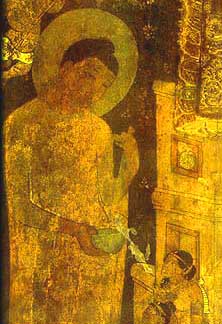 The arched chaitya window set into the elegantly simple facade of cave 9 (first century B.C.) is repeated in the elaborate frontage of cave 19 (fifth century), which has figures of Buddha on the portico. This is a fully developed chaitya with a stupa enclosing a standing Buddha at the far end. Of particular note here is a sculpture of a seated Nagaraja with his consort and female attendant. Cave 16 is an elegant vihara with an inscription that mentions the king and his minister who built this cave. The shrine has a towering figure of Buddha preaching, flanked by attendants.
The arched chaitya window set into the elegantly simple facade of cave 9 (first century B.C.) is repeated in the elaborate frontage of cave 19 (fifth century), which has figures of Buddha on the portico. This is a fully developed chaitya with a stupa enclosing a standing Buddha at the far end. Of particular note here is a sculpture of a seated Nagaraja with his consort and female attendant. Cave 16 is an elegant vihara with an inscription that mentions the king and his minister who built this cave. The shrine has a towering figure of Buddha preaching, flanked by attendants.

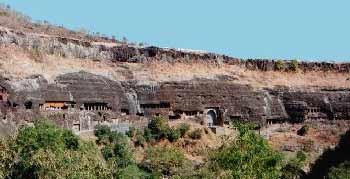 Under the royal patronage of ruling dynasties, professional artists helped the monks and left a record of contemporary life in palaces along with tales of piety and faith. Narrative panels in the caves illustrate stories from the Jatakas - the large collection of tales of the previous birth of Buddha and his increasing strength and moral stature through one incarnation after another. Symbolic of the soul's long journey through many births, these tales for the benefit and instruction of people are depicted here in artistic detail.
Under the royal patronage of ruling dynasties, professional artists helped the monks and left a record of contemporary life in palaces along with tales of piety and faith. Narrative panels in the caves illustrate stories from the Jatakas - the large collection of tales of the previous birth of Buddha and his increasing strength and moral stature through one incarnation after another. Symbolic of the soul's long journey through many births, these tales for the benefit and instruction of people are depicted here in artistic detail.
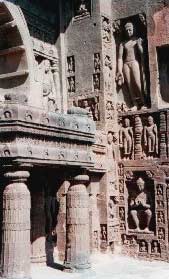 The nymphs, princesses and attendants of Ajanta are women of exquisite elegance and charm, hair dressed in intricate styles and jewels highlighting slender necks and waists.
The nymphs, princesses and attendants of Ajanta are women of exquisite elegance and charm, hair dressed in intricate styles and jewels highlighting slender necks and waists.
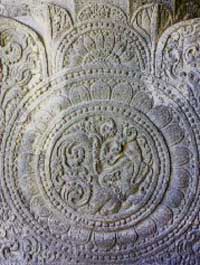 In their range of time and treatment the paintings at Ajanta are a panorama of life in ancient India and could well be studied for a description of the culture of those times -- the architectural details of buildings, the variety of textiles used for the different purposes, hair styles, ornaments and jewellery, family life, court scenes, street scenes, musicians and their instruments and many beasts and birds and flowers. Grace, lightness and movement infuse these paintings which never seem still -- a swirling many-splendoured pageantry of life.
In their range of time and treatment the paintings at Ajanta are a panorama of life in ancient India and could well be studied for a description of the culture of those times -- the architectural details of buildings, the variety of textiles used for the different purposes, hair styles, ornaments and jewellery, family life, court scenes, street scenes, musicians and their instruments and many beasts and birds and flowers. Grace, lightness and movement infuse these paintings which never seem still -- a swirling many-splendoured pageantry of life.
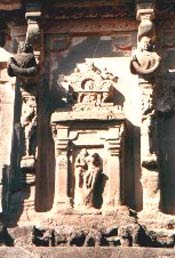 The deep relief of the Shaivite themes that so profusely ornament the Kailasa temple make them appear almost like free standing sculptures. The Kailasa temple alone would absorb all your time in Ellora. Yet there is so much here...
The deep relief of the Shaivite themes that so profusely ornament the Kailasa temple make them appear almost like free standing sculptures. The Kailasa temple alone would absorb all your time in Ellora. Yet there is so much here...